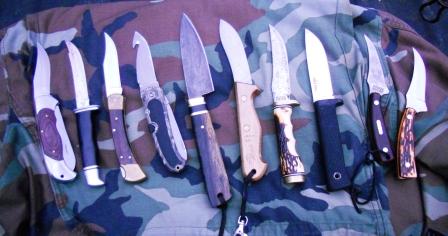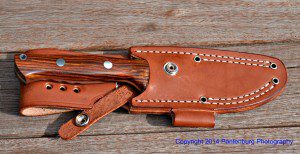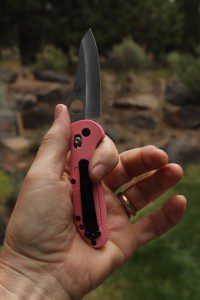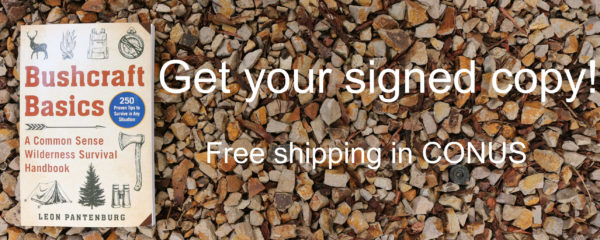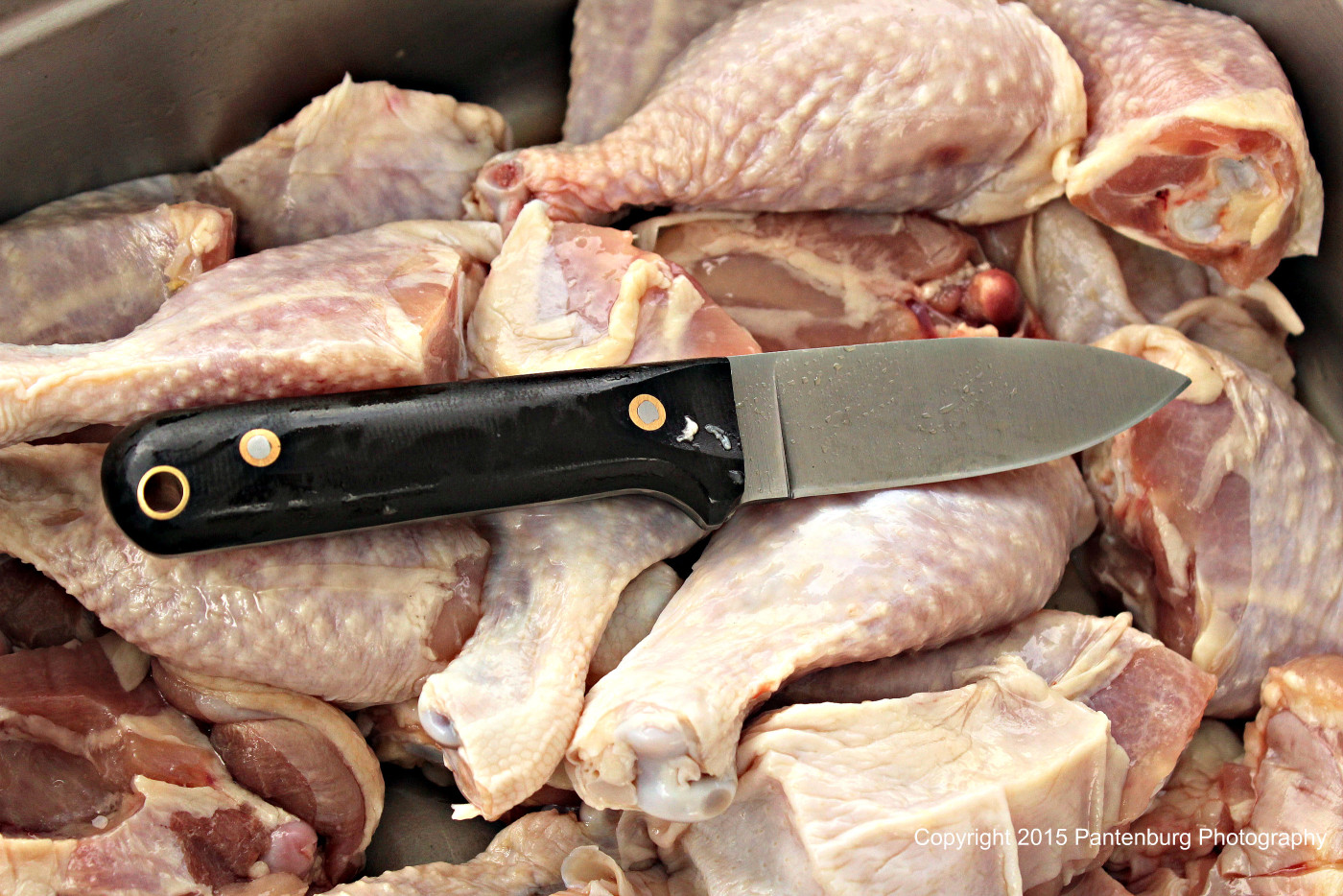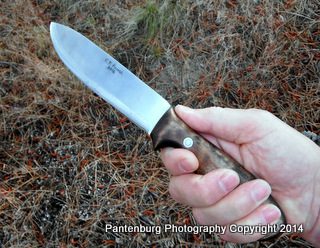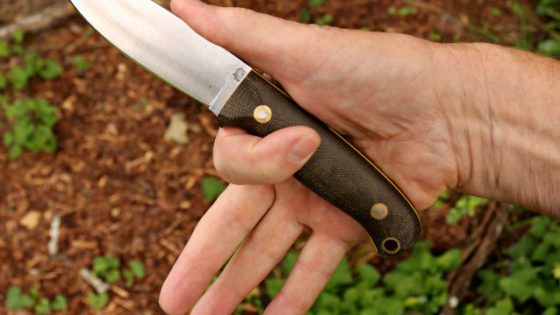Everyone has different ideas about what they need in a survival/bushcraft knife. Here’s my preferences.
by Leon Pantenburg
One of the most popular posts on the SurvivalCommonSense.com YouTube channel is Survival knives: Five things to avoid when choosing a survival/hunting knife.
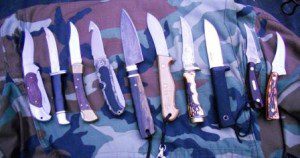
These knives are carried by the elk hunters I hunt with. The designs and styles reflect different opinions on what makes the best hunting knife!
But this has lead several viewers to comment: “Well then, what things do you look for?”
Let’s start by deciding what this conversation is about.
In this case, we’re considering that mythical, all-around, “If you could only have one” knife that would be able to do everything.
It should be a good bushcraft knife. You may be whittling sticks, cleaning fish, processing tinder, stripping back etc. for long periods of time.
The knife must also be able to handle survival tasks, such as field dressing animals, building shelters, cutting rope and whatever comes along. In the worst case scenario, the knife would have to be an effective weapon.
This perfect, jack-of-all-trades knife doesn’t exist. What works for me might be a bad choice for you. The best advice might be to consider possible survival scenarios, what tasks might arise from it and what knife would work best. That being said:
Here we go:
Folder or rigid blade?
I carry a folder every day. I carried a Buck folding hunting knife on my 1980 end-to-end Mississippi River voyage and it worked just fine. Later, I used that same Buck to field dress my first deer. To date, that knife has processed thousands of fish and many small game animals.
But I won’t carry a folder as my backcountry survival knife. The weak point of any folder is the hinge. Break that, and you end up with two pieces.
As a cooking knife, the folder’s hinge and blade slot could get all sorts of disgusting stuff in it that you don’t want in food.
I choose a rigid blade knife, but that doesn’t mean it is the best choice for all situations.
In an urban environment, discretion during a disaster might be the best course. A folder with a decent-sized 3-1/2-to-4-inch blade can be more easily concealed than a rigid blade knife. And, a non-descript looking pocket knife is a lot less threatening looking to some people than a rigid blade.
Steel: At some point, the blade will need sharpening, and you must be able to do it easily. There are many fine carbon steels and they are usually easier to sharpen than many stainless varieties. The downside is that carbon steel can rust in humid climates, and over time, they will build up a patina.
My preferences in blades runs toward 1075 and 1095 carbon steel, CPM 3V and A2. A reputable knife maker must use good steel. Ask around and see what other knowledgeable users recommend.
Full tang: This refers to a blade that runs completely through the handle. This is the strongest option and what I prefer.
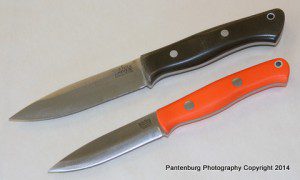
The Bark River Aurora, top, and Liten Bror are high-end full-tang bushcraft knives that can get the job done.
Blade length: A blade between four to six inches works for me. Now, don’t write in and tell me how you’ve field-dressed all sorts of big game with your pocketknife! Sure it can be done – legendary outdoors writer Jack O’Connor used a basic pocket knife for most of his big game field work.
But for a big game hunting knife, a four-inch blade is all you need. I prefer about a five-inch blade in an overall knife. (Check out blade length.)
Blade thickness: Many professional butcher knives have relatively thin blades, because their purpose is to slice effectively. I like about a 1/8-inch thickness. For me, it is the best compromise, and it will slice, whittle and cut, without being so thick as to be ineffective.
For a fillet or boning knife, you want a thin blade with some flexibility. For a hunting knife, a sturdy blade that can take the hard twisting and cutting of field dressing a large animal is best.
Spine: I want the spine to be ground like an ice skate, with 90-degree angles. This allows you to scrape a ferrocerium rod to make sparks, shave pitchwood for tinder and other tasks that save the edge.
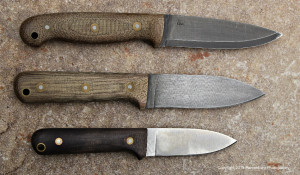
The L.T. Wright GNS (top), Genesis and Next Gen all have understated, well-designed handles.
Handle: One of the more overlooked design features is the handle. In a survival/bushcraft knife, you may need to use the knife for long periods of time to process tinder, carve wood, make shelters etc. How well the handle fits your hand is more important than what it is made of. I have knives with smooth, well-designed handles that are safer than others with soft, squishy handles.
The last time I cut myself with a knife was because of a handle failure and stupidity on my part. I was using a name brand bread slicing knife with a slender, skinny handle. It fits my wife perfectly, but the handle twisted in my hand and caused the blade to slip.
Choose the handle by physically trying it out if possible. If you order a knife from a reputable company, they will allow you to exchange it. Don’t put up with a handle that doesn’t feel right.
Sheath: A well-designed sheath secures the blade and keeps it from being dangerous. It also must be convenient to carry. In an emergency situation, you may be wearing your knife all the time, and it must ride comfortably.
Point design: This is another aspect you’ll have to decide. In this case, I narrow point design down to drop, clip and spear. Any of these will work well. The drop point is my favorite for an overall knife, but I really like clip points, just because of the looks. (For more info on point choices, check this out.)
Blade grind: I don’t want serrations or any other specialty grind. For a do-it-all, choose between a convex, Scandi or flat grind. Any of these will serve you well. In this particular case, I might lean toward a Scandi. The Scandi grind creates a good wedge, which works well for splitting wood. It’s also easy to sharpen.
But most of my favorite user knives have a convex grind. I find the convex stays sharper longer, and makes a better skinning knife. Either a convex or Scandi will work fine.
That was ten, here are two bonus things to look for:
Warranty: The only warranty I’m interested in is the unconditional, lifetime type. A manufacturer can’t afford to replace a lot of knives regularly, and a lifetime warranty shows credibility. I like knowing there is a no-hassle clause in my investment.
Not tacticool: The fast-opening, black-colored combat knives don’t do much for me. And a knife designed primarily for fighting probably won’t be the best all-around user knife.
I go for urban camouflage when possible. I got my daughter a Benchmade Griptillian with pink grips and my son a Griptillian in orange. They look cute and non-threatening, but are solid, dependable knives.
So in the final analysis, for a do-it-all survival/bushcraft knife my needs will best be met with a four-inch, 1/8-inch thick, Scandi or convex grind rigid blade, drop point knife. It must be full tang, with a well-designed handle. The knife will come with a safe, well-designed sheath that is comfortable to carry. It will be unconditionally guaranteed, and preferably, made in America.
This type of knife works for me. Hopefully, you can use my choices as a place to start your own shopping.
Bottom line: It has to work for you.
Please click here to check out and subscribe to the SurvivalCommonSense.com YouTube channel, and here to subscribe to our email update – thanks!

